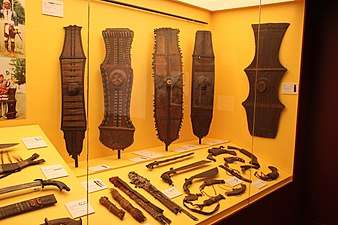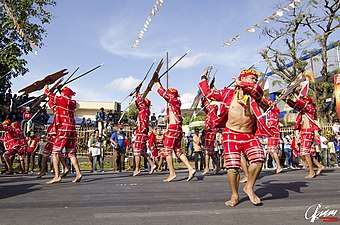Kalasag
The kalasag (Spanish: carasas) is a large rectangular myth-motif shield used by the natives in the Philippines. The shield is made of hardwood and is decorated with elaborate carvings.[1] The wood comes from native trees such as the dapdap, polay and sablang.[2] The shield measured about 1.5 m (4.9 ft) in length. Its base is composed of rattan wood which is strengthened by the application of resin.[3]
It was widely used throughout the Philippines for warfare. Datu Lapu-Lapu was reported to have used this shield during the Battle of Mactan in 1521. Its shape is commonly used as part of the official seal of the Philippine National Police. Various kinds of kalasag are also represented in the provincial flags of Bukidnon, Maguindanao, and Mountain Province.
The officers who bears the royal regalia of the Sultan of Brunei such as the Panglima Agsar, carries the royal weapons of kelasak (shield) and kampilan (sword).[4]
.png) Bagobo warriors from Davao (1926), the warrior in the center is holding a kalasag
Bagobo warriors from Davao (1926), the warrior in the center is holding a kalasag Various kinds of kalasag from Mindanao displayed in the National Museum of Anthropology
Various kinds of kalasag from Mindanao displayed in the National Museum of Anthropology.jpg) A Moro kalasag (c. 1905)
A Moro kalasag (c. 1905).jpg) An Igorot kalasag (c. 1905)
An Igorot kalasag (c. 1905) Manobo kalasag and spears during the 2016 Kaamulan Festival
Manobo kalasag and spears during the 2016 Kaamulan Festival.jpg) A 1922 photograph of a shaman of the Itneg people renewing an offering to the spirit (anito) of a warrior's kalasag
A 1922 photograph of a shaman of the Itneg people renewing an offering to the spirit (anito) of a warrior's kalasag
References
- New York Academy of Sciences, Synergy (Online service) (1917). Annals of the New York Academy of Sciences. New York Academy of Sciences. p. 236.
- Dozier, Edward P. (1966). Mountain Arbiters: The Changing Life of a Philippine Hill People. University of Arizona Press. p. 131. Retrieved 2008-08-11.
- Junker, Laura Lee (1999). Raiding, Trading and Feasting. University of Hawaii Press. p. 352. ISBN 978-0-8248-2035-0. Retrieved 2008-08-11.
- Siti Norkhalbi Haji Wahsalfelah (2007). Textiles and Identity in Brunei Darussalam. White Lotus Press. ISBN 974-480-094-1.
See also
- Filipino Martial Arts
- Arnis